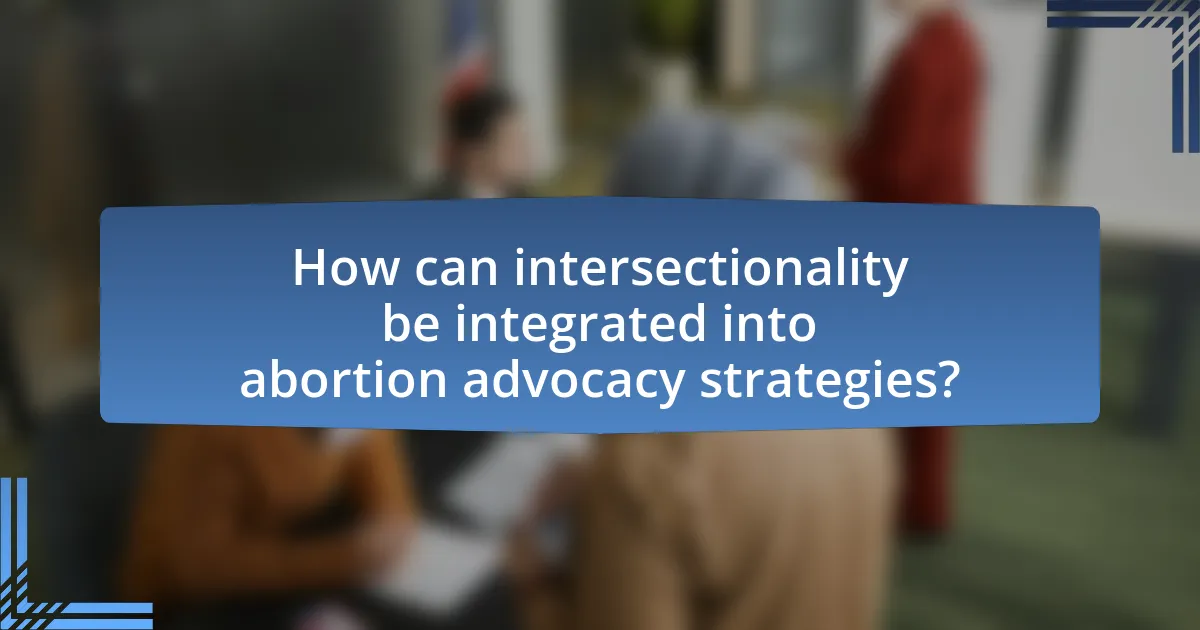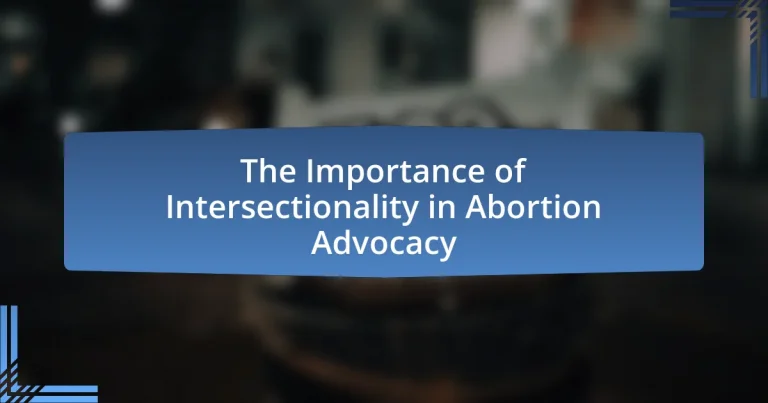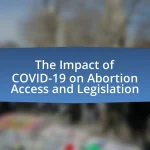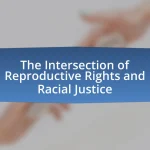The article focuses on the significance of intersectionality in abortion advocacy, emphasizing how overlapping identities such as race, gender, socioeconomic status, and sexual orientation influence individuals’ experiences and access to reproductive healthcare. It highlights the unique barriers faced by marginalized groups, particularly women of color and low-income individuals, in obtaining abortion services due to systemic inequalities. The article discusses the necessity of incorporating intersectional perspectives into advocacy efforts to create inclusive policies that address these diverse needs, ultimately promoting equitable access to reproductive healthcare for all individuals. Additionally, it outlines strategies for effective advocacy, the importance of genuine representation, and the potential consequences of neglecting intersectionality in the discourse surrounding abortion rights.

What is the Importance of Intersectionality in Abortion Advocacy?
Intersectionality is crucial in abortion advocacy because it recognizes that individuals experience oppression differently based on overlapping identities such as race, gender, socioeconomic status, and sexual orientation. This framework allows advocates to address the unique barriers faced by marginalized groups in accessing abortion services. For instance, Black and Latina women often encounter systemic racism and economic disparities that complicate their reproductive choices, as highlighted by the Guttmacher Institute, which reports that women of color are disproportionately affected by restrictive abortion laws. By incorporating intersectionality, abortion advocacy can create more inclusive policies that address these diverse needs, ultimately leading to equitable access to reproductive healthcare for all individuals.
How does intersectionality influence the discourse around abortion rights?
Intersectionality significantly influences the discourse around abortion rights by highlighting how various social identities, such as race, class, gender, and sexuality, intersect to shape individuals’ experiences and access to reproductive healthcare. This framework reveals that marginalized groups, particularly women of color and low-income individuals, face compounded barriers to accessing abortion services, including systemic racism, economic inequality, and lack of healthcare resources. For instance, studies show that Black women are disproportionately affected by restrictive abortion laws due to socioeconomic factors and historical injustices, which underscores the necessity of considering these intersecting identities in advocacy efforts. By integrating intersectionality into the conversation, advocates can better address the unique challenges faced by diverse populations, ultimately leading to more equitable policies and support systems for abortion rights.
What are the key components of intersectionality in the context of abortion advocacy?
The key components of intersectionality in the context of abortion advocacy include the recognition of how various social identities—such as race, gender, class, and sexuality—intersect to shape individuals’ experiences and access to reproductive healthcare. This framework emphasizes that marginalized groups face unique barriers to abortion access, influenced by systemic inequalities. For instance, Black and Latina women often encounter higher rates of maternal mortality and limited healthcare resources, which highlights the need for tailored advocacy that addresses these disparities. Additionally, intersectionality advocates for inclusive policies that consider the diverse needs of all individuals, ensuring that abortion rights are not just a privilege for some but accessible to everyone, regardless of their social identity.
How does intersectionality affect the experiences of different groups in accessing abortion services?
Intersectionality significantly affects the experiences of different groups in accessing abortion services by highlighting how overlapping social identities, such as race, class, gender, and sexual orientation, create unique barriers. For instance, marginalized groups, including low-income women and women of color, often face systemic obstacles like lack of transportation, financial constraints, and limited access to healthcare facilities, which can hinder their ability to obtain abortion services. Research from the Guttmacher Institute indicates that women of color are disproportionately affected by restrictive abortion laws and have higher rates of unintended pregnancies, further complicating their access to necessary services. This intersectional lens reveals that the challenges faced by individuals are not solely based on gender but are compounded by various social determinants, necessitating tailored advocacy efforts to address these disparities effectively.
Why is understanding intersectionality crucial for effective abortion advocacy?
Understanding intersectionality is crucial for effective abortion advocacy because it recognizes that individuals experience multiple, overlapping forms of discrimination that affect their access to reproductive healthcare. For instance, women of color, low-income individuals, and LGBTQ+ people face unique barriers that differ from those encountered by white, affluent women. Research shows that marginalized groups are disproportionately affected by restrictive abortion laws, highlighting the need for advocacy that addresses these specific challenges. By incorporating intersectional perspectives, advocates can create more inclusive policies and strategies that better serve diverse populations, ultimately leading to more equitable access to abortion services.
What are the potential consequences of ignoring intersectionality in abortion advocacy?
Ignoring intersectionality in abortion advocacy can lead to the marginalization of specific groups, resulting in policies that do not address the unique needs of diverse populations. For instance, women of color, low-income individuals, and LGBTQ+ communities often face compounded barriers to accessing abortion services, such as systemic racism, economic inequality, and discrimination. Research indicates that without an intersectional approach, advocacy efforts may overlook these complexities, ultimately perpetuating inequities in healthcare access and outcomes. This lack of inclusivity can alienate affected communities, reduce the effectiveness of advocacy campaigns, and hinder the overall progress toward reproductive justice.
How can intersectionality enhance the inclusivity of abortion advocacy efforts?
Intersectionality can enhance the inclusivity of abortion advocacy efforts by recognizing and addressing the diverse experiences and needs of individuals affected by abortion access. This approach acknowledges that factors such as race, class, gender identity, sexual orientation, and disability intersect to shape people’s experiences with reproductive health services. For instance, studies show that marginalized groups, including women of color and low-income individuals, face greater barriers to accessing abortion services, highlighting the necessity for advocacy that is tailored to these unique challenges. By incorporating intersectional perspectives, abortion advocacy can create more comprehensive policies and outreach strategies that ensure equitable access for all individuals, ultimately fostering a more inclusive movement.

What are the different dimensions of intersectionality in abortion advocacy?
The different dimensions of intersectionality in abortion advocacy include race, class, gender identity, sexual orientation, and disability. These dimensions highlight how individuals experience abortion access and rights differently based on their intersecting identities. For instance, women of color often face systemic barriers that white women may not encounter, such as higher rates of poverty and discrimination in healthcare settings. Additionally, LGBTQ+ individuals may experience unique challenges related to reproductive health services, while those with disabilities may confront physical and societal obstacles that hinder access to abortion. Research by the Guttmacher Institute indicates that marginalized groups are disproportionately affected by restrictive abortion laws, underscoring the necessity of an intersectional approach in advocacy efforts to ensure equitable access for all individuals.
How do race and ethnicity intersect with abortion rights?
Race and ethnicity significantly intersect with abortion rights by influencing access to reproductive healthcare and shaping the experiences of individuals seeking abortions. For instance, studies show that women of color, particularly Black and Latina women, face systemic barriers such as socioeconomic disparities, lack of healthcare access, and discriminatory practices that limit their reproductive choices. According to the Guttmacher Institute, Black women are more likely to experience unintended pregnancies and have higher abortion rates compared to their white counterparts, largely due to these intersecting factors. Additionally, cultural stigmas and varying community attitudes towards abortion further complicate the decision-making process for individuals from diverse racial and ethnic backgrounds. This intersectionality highlights the need for tailored advocacy that addresses the unique challenges faced by marginalized groups in the context of abortion rights.
What unique challenges do women of color face in accessing abortion services?
Women of color face unique challenges in accessing abortion services, primarily due to systemic racism, socioeconomic disparities, and limited healthcare access. These challenges manifest in various ways, including higher rates of poverty, which can restrict financial resources for abortion services, and geographic barriers, as many women of color live in areas with fewer clinics. According to the Guttmacher Institute, Black and Latina women are disproportionately affected by restrictive abortion laws and face higher rates of unintended pregnancies, further complicating their access to necessary healthcare. Additionally, cultural stigma surrounding abortion within some communities can deter women of color from seeking services.
How can advocacy efforts be tailored to address these challenges?
Advocacy efforts can be tailored to address challenges in abortion advocacy by incorporating intersectional approaches that consider the diverse experiences of individuals affected by abortion policies. This involves recognizing how factors such as race, socioeconomic status, gender identity, and geographic location intersect to create unique barriers to access. For instance, research from the Guttmacher Institute indicates that marginalized communities face higher rates of unintended pregnancies and limited access to reproductive healthcare, necessitating targeted outreach and support services. By developing campaigns that specifically address these disparities, advocacy groups can more effectively mobilize resources and create inclusive policies that resonate with the needs of all individuals, particularly those most impacted by restrictive abortion laws.
What role does socioeconomic status play in abortion access?
Socioeconomic status significantly influences abortion access, as individuals with lower income levels often face greater barriers to obtaining abortion services. Research indicates that financial constraints can limit access to necessary healthcare, including abortion, with studies showing that low-income women are more likely to encounter obstacles such as travel distance to clinics, inability to afford the procedure, and lack of insurance coverage. For instance, a study published in the American Journal of Public Health found that women with incomes below the federal poverty level were more likely to report difficulties in accessing abortion services compared to those with higher incomes. This disparity highlights the critical role socioeconomic factors play in shaping reproductive health outcomes and underscores the need for policies that address these inequities.
How does economic inequality impact the ability to obtain abortion services?
Economic inequality significantly restricts access to abortion services, particularly for low-income individuals. Those with limited financial resources often face barriers such as the inability to afford the procedure, travel costs to clinics, and associated expenses like childcare or time off work. According to the Guttmacher Institute, individuals living below the federal poverty level are more likely to experience unintended pregnancies and have less access to abortion services compared to their wealthier counterparts. This disparity highlights how economic status directly influences reproductive health choices and outcomes, reinforcing the need for intersectional approaches in abortion advocacy that address these inequalities.
What strategies can be implemented to support low-income individuals seeking abortions?
To support low-income individuals seeking abortions, implementing financial assistance programs is essential. These programs can provide direct funding for abortion services, covering costs that low-income individuals may struggle to afford. For instance, organizations like the National Network of Abortion Funds have reported that they help thousands of individuals each year by providing financial support, which is crucial given that the average cost of an abortion can range from $300 to $1,500, depending on the gestational age and location. Additionally, expanding access to telehealth services can facilitate consultations and follow-up care, reducing barriers related to transportation and time off work. Research indicates that telehealth can improve access to care, particularly for marginalized communities. Furthermore, advocacy for policy changes that protect and expand Medicaid coverage for abortion services can significantly alleviate financial burdens for low-income individuals, as many states currently do not cover abortion under Medicaid.

How can intersectionality be integrated into abortion advocacy strategies?
Intersectionality can be integrated into abortion advocacy strategies by recognizing and addressing the diverse experiences and needs of individuals affected by abortion access. This approach involves tailoring advocacy efforts to consider factors such as race, socioeconomic status, gender identity, and geographic location, which significantly influence access to reproductive healthcare. For instance, studies show that marginalized communities face higher barriers to abortion services, including financial constraints and lack of local providers. By incorporating these insights, advocacy groups can develop targeted campaigns that address specific barriers faced by different populations, ensuring that all voices are represented and that policies reflect the complexities of individuals’ lived experiences.
What best practices should advocates follow to incorporate intersectionality?
Advocates should prioritize inclusive representation and actively engage with diverse communities to incorporate intersectionality effectively. This involves recognizing and addressing the unique experiences and challenges faced by individuals at the intersections of various identities, such as race, gender, socioeconomic status, and sexual orientation. For instance, research by the Center for American Progress highlights that marginalized groups often experience compounded barriers to accessing abortion services, emphasizing the need for tailored advocacy strategies that reflect these complexities. By fostering collaboration with grassroots organizations and amplifying the voices of those most affected, advocates can ensure that their efforts are equitable and responsive to the diverse needs within the abortion advocacy landscape.
How can data collection on diverse populations improve advocacy efforts?
Data collection on diverse populations can significantly enhance advocacy efforts by providing targeted insights into the unique needs and challenges faced by different groups. This specificity allows advocates to tailor their strategies and messaging, ensuring that they resonate with various communities. For instance, research from the Guttmacher Institute indicates that understanding the socioeconomic factors affecting marginalized populations can lead to more effective policy recommendations and resource allocation. By leveraging data, advocates can identify gaps in services and address disparities in access to abortion care, ultimately fostering a more inclusive approach to reproductive rights.
What collaborative approaches can enhance intersectional advocacy?
Collaborative approaches that can enhance intersectional advocacy include coalition-building, shared resources, and inclusive dialogue. Coalition-building allows diverse groups to unite around common goals, leveraging their unique perspectives and strengths to address complex issues effectively. For instance, organizations representing marginalized communities can collaborate with reproductive rights groups to ensure that the specific needs of those communities are prioritized in advocacy efforts. Shared resources, such as data and funding, enable these groups to amplify their impact and reach a broader audience. Inclusive dialogue fosters understanding and respect among different advocacy groups, ensuring that all voices are heard and considered in decision-making processes. Research shows that intersectional approaches lead to more comprehensive and effective advocacy outcomes, as they address the multifaceted nature of social issues, particularly in contexts like abortion rights, where race, gender, and socioeconomic status intersect.
What are the common pitfalls in intersectional abortion advocacy?
Common pitfalls in intersectional abortion advocacy include oversimplification of diverse experiences, lack of inclusivity, and failure to address systemic inequalities. Oversimplification occurs when advocates do not recognize the unique challenges faced by different groups, such as women of color, low-income individuals, and LGBTQ+ communities, leading to a one-size-fits-all approach that fails to meet specific needs. Lack of inclusivity can manifest in the exclusion of marginalized voices from discussions and decision-making processes, which undermines the effectiveness of advocacy efforts. Additionally, failing to address systemic inequalities, such as racism, classism, and ableism, can result in advocacy that does not challenge the root causes of reproductive injustice, thereby limiting its impact. These pitfalls highlight the necessity for a nuanced understanding of intersectionality to create effective and equitable abortion advocacy strategies.
How can advocates avoid tokenism in their efforts?
Advocates can avoid tokenism by actively engaging with and amplifying the voices of marginalized communities in their efforts. This involves prioritizing genuine collaboration, ensuring that individuals from diverse backgrounds are not only included but also have decision-making power in advocacy initiatives. Research indicates that inclusive practices lead to more effective advocacy outcomes, as seen in the 2018 study by Crenshaw, which highlights the necessity of intersectional approaches in social justice movements. By fostering authentic partnerships and valuing the lived experiences of all stakeholders, advocates can create a more equitable and impactful advocacy landscape.
What steps can be taken to ensure genuine representation of marginalized voices?
To ensure genuine representation of marginalized voices, organizations must actively include individuals from these communities in decision-making processes. This can be achieved by implementing policies that prioritize hiring and promoting diverse staff, particularly those with lived experiences related to the issues at hand. Research indicates that organizations with diverse leadership are more effective in addressing the needs of marginalized groups, as they bring unique perspectives and insights that can inform better practices and policies. Additionally, creating platforms for marginalized voices to share their stories and experiences can foster a more inclusive dialogue, ensuring that advocacy efforts reflect the realities of those most affected.
What practical steps can advocates take to promote intersectionality in their work?
Advocates can promote intersectionality in their work by actively incorporating diverse perspectives and experiences into their advocacy strategies. This can be achieved by conducting inclusive research that highlights the unique challenges faced by marginalized groups, such as women of color, LGBTQ+ individuals, and low-income communities, in accessing abortion services. For instance, studies have shown that women of color are disproportionately affected by restrictive abortion laws, which underscores the need for tailored advocacy efforts that address these disparities. Additionally, advocates should collaborate with grassroots organizations that represent these communities to ensure that their voices are heard and prioritized in policy discussions. Engaging in intersectional training and education can also equip advocates with the necessary tools to understand and address the complexities of identity and oppression in their work.


